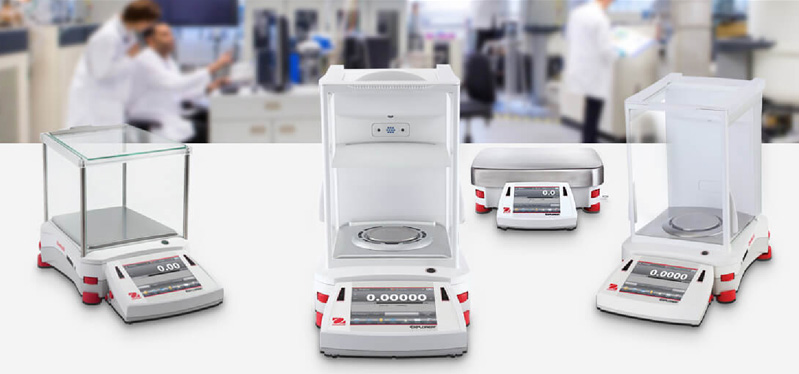Members Login

Channels
Special Offers & Promotions
Controlling Environmental Factors That Affect Weighing Performance

Learn how to identify and mitigate external influences that can negatively impact weighing results.
Achieving reliably precise weighing results in a laboratory setting is of utmost importance. The three most critical factors are selecting the right high-quality balance, understanding how to use it, and mitigating environmental factors that can impact results.
Environmental Factors
To achieve optimal performance, it is critical to setup and use the balance in a controlled and stable environment. Identifying environmental influences that can adversely impact weighing results starts with a check list of factors. Temperature, humidity, air flow, electrostatic charges, and vibrations can all affect samples and or weighing results. Additionally, a stable power supply is essential as unsteady voltage can affect readings.
Changes in temperature and humidity can result in expansion and contraction of materials such as metals and adhesives. The changes are nearly imperceptible, however, in high-precision applications, this can create challenges. Whenever possible, a balance should be used in a controlled environment with a constant ambient temperature and humidity. In the event of a change in ambient conditions, the balance should be re-adjusted.
Additionally, a balance should be kept out of direct sunlight and away from heating or cooling vents. Drafts can cause instability and negatively impact weighing performance. Sources of air movement include HVAC vents, fans, windows, cryogenic refrigerators muffle furnaces, and doorways. A poorly insulated room may present other, less obvious draft sources as well. This is an important consideration as even light variations in air movement can affect room temperature. Some balances are equipped with draft shields that enclose the, pan and prevent disruptions caused by drafts. Balances should be kept out of the path of any potential drafts, either directly from a vent or fan, or in an environment with more than one opening that could create a wind tunnel effect.
A buildup of static charges can also adversely affect weighing performance. Static charges can create an attracting or repelling force on an object which can impact stability and lead to inconsistent weighing results. This is more of a concern with high-precision weighing done with analytical and semi-micro balances. The risk of static charges can be mitigated by increasing the relative humidity in the room, adjusting how sample materials are stored or handled, using tare containers that are less prone to static (e.g. glass over plastic), or using external devices such as a static ionizer.
One of the biggest culprits among environmental factors is vibration. Balances should always be placed on solid, stable work surfaces that are either free standing or anchored to the floor. A table that adjoins another or butts up against a wall is more likely to create vibration. Foot traffic, HVAC equipment, and other machinery or instruments, including centrifuges, can also create vibration. Ideally, the table used for weighing should not be used simultaneously for other activities.
Precision and Analytical Balances
Once you’ve created a stable working environment, select a reliably precise balance that meets your needs. OHAUS offers a range of precision and analytical balances suited to a range of laboratory weighing applications.
OHAUS laboratory balances include different features and specifications to optimally support your application needs. Before selecting a model, you should consider what type of samples you will be weighing, which weighing applications you will need, what additional connectivity is offered and what advanced features you may need. Additionally, you should consider the maximum capacity and level of accuracy needed.
To measure small mass samples, power samples, or USP reference standard (expensive sample) great precision, an analytical balance is suitable. OHAUS Analytical balances are capable of measuring samples up to 320g with readability to 0.01mg accuracy. An analytical balance is especially sensitive to environmental factors so many models come equipped with a draft shield to help ensure accurate readings. Analytical balances are often used in chemistry and pharmaceutical applications.
For higher capacity weighing, OHAUS precision balances are capable of measuring up to 35kg samples, offer rapid results, and offer readability up to 1mg.
Proper Usage is Essential
Once you’ve selected the right balance for your needs and ensured that your weighing station is suitable for avoiding unwanted environmental influences, the last step is to make sure you are using the balance properly. OHAUS offers our customers a comprehensive and free, expert weighing guide.
The OHAUS Weighing Guide is packed with valuable, in-depth information created to help you understand weighing and various concepts within the weighing industry. Our comprehensive Weighing Guide includes topics such as:
- How an electronic balance works
- Terminology and concepts related to weighing
- Balance installation and setup (as well as explaining "IQ/OQ/PQ")
- Understanding accuracy and uncertainty
- Legal metrology ("Legal-For-Trade"), and how to understand requirements and select an appropriate balance
- Calibration weights
- Regulated weighing including FDA CFR21 sections such as "GMP/GLP" etc. and USP
About OHAUS Corporation
Headquartered in Parsippany, NJ, OHAUS Corporation manufactures an extensive line of balances and scales, lab equipment and lab instruments that meet the weighing, sample processing and measurement needs of multiple industries. We are a global leader in the laboratory, industrial and education markets, as well as a host of specialty markets, including the food preparation, pharmacy and jewelry industries. An ISO 9001:2015 manufacturer, OHAUS produces lab balances, industrial scales, lab equipment and lab instruments that are precise, reliable and affordable, and backed by industry-leading customer support.
Media Partners


